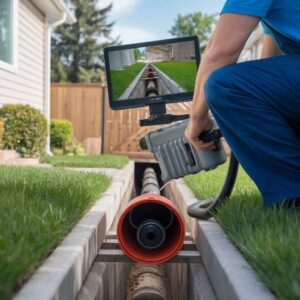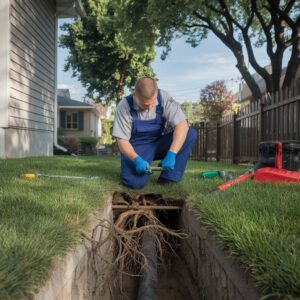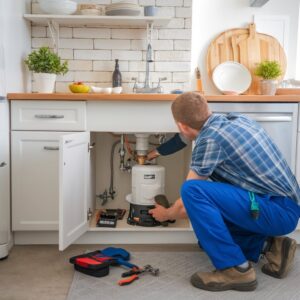A tankless water heater is a compact, on-demand system that heats water only when you turn on a hot water tap. Cold water flows through a heat exchanger warmed by gas burners or electric elements, delivering continuous hot water within its flow-rate limits. It saves energy by avoiding standby heat loss, frees up space, and can last longer than tank models. Proper sizing, fuel and venting needs, and annual descaling matter. Upfront cost is higher, but utility savings and performance often justify it—here’s what to know next.
Key Takeaways
- A tankless water heater heats water on demand as it flows, instead of storing hot water in a tank.
- It uses gas burners or electric elements to instantly raise water temperature, delivering nearly endless hot water within its flow-rate limit.
- Efficiency is higher because energy is used only when hot water is needed, reducing standby heat losses and utility bills.
- Proper sizing matches unit flow rate to simultaneous fixture demand and groundwater temperature to maintain desired output temperature.
- Installation requires correct gas/electrical capacity, code-compliant venting, and maintenance valves; annual descaling keeps performance and longevity high.
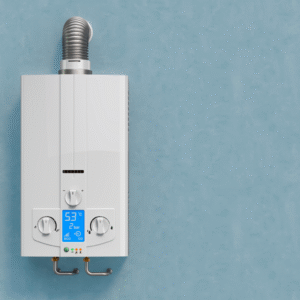
Understanding Tankless Water Heaters
This section explains what a tankless water heater is and how it works.
It also compares tankless units with traditional tank systems in simple terms: how they heat water, energy use, space needs, and costs.
Finally, it highlights why tankless heating is gaining popularity today, from efficiency to convenience.
What is a Tankless Water Heater?
A tankless water heater provides hot water on demand instead of storing it in a tank. Water heater leaking is a common issue with traditional tank systems, but since a tankless system doesn’t store water, it eliminates the risk of leaks caused by corrosion or tank failure. It senses water flow, then uses burners or heating elements to warm the water as it passes through a compact unit.
Because it delivers water on demand, many users enjoy nearly endless hot water, limited mainly by the flow rate of hot water the unit can produce.
A gas tankless water heater suits higher demands; an electric tankless water heater fits smaller loads or tight spaces.
Tankless vs Traditional Tank Water Heater Explained
Although both deliver hot water, tankless and traditional tank heaters work very differently—and that shapes cost, comfort, and energy use. A tankless water heater uses powerful burners or elements to heat water on demand. A traditional water heater, including storage tank water heaters, keeps a tank hot around the clock. Tankless units reduce standby loss and can boost water heating efficiency, but may need proper sizing. Tanks are simpler, yet can run out of hot water.
| Feature | Tankless vs Traditional |
|---|---|
| Hot water supply | Endless vs finite |
| Efficiency | Higher vs lower |
| Space | Compact vs bulky |
| Upfront | Cost of a tankless water higher |
| Install choice | Install a tankless water heater vs replace tank |
Why Tankless Water Heating is Popular Today
Driven by rising energy costs and smaller living spaces, homeowners are turning to tankless water heaters for efficient, on-demand comfort.
People value the benefits of tankless water heaters: they deliver hot water on demand, often more efficient than storage tank water systems, and free up closet space.
A tankless water heater uses energy only when needed, supporting lower utility bills. Many see the appeal of an endless supply of hot water for showers and laundry.
Though tankless water heaters require proper sizing and venting, installing a new tankless water is straightforward for pros.
Buyers compare options to match hot water needs and budget.
How Tankless Water Heater Works
A tankless water heater warms water only when a tap turns on, using powerful burners or heating elements as it flows through.
This on-demand process supports steady hot water and cuts standby energy waste.
Compared with a tank model, it skips storing gallons, heats faster, heats water as it flows, and often runs more efficiently.
The Process of On-Demand Water Heating
When a hot water tap opens, a flow sensor inside the tankless unit wakes the system and signals the burner or electric elements to fire up.
This is how a tankless water heater works: it detects water flow, modulates power, and begins to heat the water. Heat exchangers raise water temperature precisely, matching water usage.
The unit measures water as it flows and adjusts flame or current to maintain set temperature. No standing tank is involved; the device delivers instant hot water only when needed.
Sensors verify outlet temperature and flow, ensuring a steady supply of hot water until the tap closes.
Endless Hot Water and Energy Efficiency
Why do tankless water heaters feel endless? A tankless water heater senses flow and fires burners or elements so water heaters heat water only as needed.
With continuous flow, they provide hot water as long as demand stays within capacity. A gas tankless water model ramps quickly, boosting energy efficiency by avoiding standby losses.
For large homes, homeowners often install two or more tankless units to meet simultaneous uses.
- Instant heating means fewer cold-shower surprises
- No stored tank reduces scale and standby waste
- Right-sized tankless system matches real demand
- Smart controls modulate output to save fuel and energy
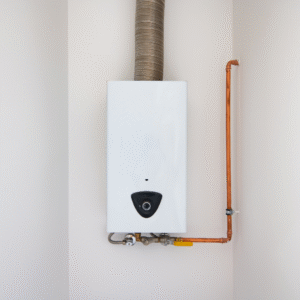
Advantages and Considerations of Tankless Water Heaters
Tankless water heaters offer on-demand hot water, energy savings, and space efficiency.
They also come with trade-offs such as higher upfront cost, potential flow limits, and installation requirements.
With these in mind, the reader can compare tankless and traditional tanks to decide which best fits their home and budget.
Benefits of Tankless Water Heating Systems
Efficiency meets convenience in modern tankless water heating. A tankless system delivers on-demand performance with clear homeowner benefits.
Because tankless water heaters provide hot water only when called, they boost energy efficiency, often leading to lower utility bills. Compact designs save space while offering endless hot water within capacity.
With a long lifespan, they can be a smart water heater for your needs, especially if a household uses less of hot water daily.
- Faster hot water delivery with minimal standby loss
- Flexible sizing for single fixtures or whole homes
- Wall-mounted units free storage areas
- Scalable options align with renovation or expansion plans
Practical Limitations to Keep in Mind
While the benefits are compelling, a few practical limits deserve attention before choosing on-demand hot water.
A tankless water heater only heats as water flows, so it delivers hot water at a rate tied to inlet temperature and the amount of water demanded. In cold seasons or with multiple hot water uses at once, there may not be enough hot water.
Gas tankless units often require larger gas lines and venting; electric tankless water models can need significant amperage.
Scale from hard water supply reduces efficiency without maintenance. Short waits for temperature stabilization are common, and minimum flow rates can interrupt heating.
Choosing Between a Tankless Heater and Tank Water Heater
How does a homeowner decide between on-demand convenience and stored hot water reliability? A tankless heater delivers continuous supply and higher efficiency for water heating, while traditional tank water models offer lower upfront costs and simpler water heater installation.
The pros and cons of tankless hinge on budget, space, and usage patterns. Water heaters provide hot water differently; tank units may run out, a tankless hot water heater does not.
- Upfront vs. lifetime cost: tankless costs more to install, less to run
- Space: tankless is compact
- Longevity: many water heaters last longer when tankless
- Capacity: match flow rates to simultaneous demand
Installing and Maintaining a Tankless Heater
Installing a tankless heater starts with a few key factors: sizing, fuel type, venting, and local codes.
Readers will see when a professional install makes sense and when a careful DIY setup could work.
Simple maintenance—like descaling, cleaning the intake screen, and checking filters—keeps efficiency high for years.
Key Factors in Water Heater Installation
Before any tankless unit goes on the wall, a few fundamentals determine a safe, efficient install and low-hassle upkeep.
Sizing matters: match flow rate to simultaneous demand at the farthest hot water faucet. Fuel and venting must suit gas water heaters or electric models. Upgrade lines as needed when switching a water heater to a tankless. Some homes also install separate tankless water heaters to zone loads.
- Verify gas, electric, and water capacities for a heater to a tankless system.
- Ensure code-compliant venting and condensate drainage.
- Plan maintenance valves for descaling.
- Position tankless water heaters for appliances near points of use.
Professional Install vs DIY Setup
With sizing, venting, and service points mapped out, the next choice is who does the work: a licensed pro or a capable homeowner. In the professional install vs diy setup debate, stakes are real. A professional ensures code, gas sizing, vent paths, and permits; the heater may perform better and keep warranties intact. DIY can cut labor costs, but mistakes with a tankless water heater can be costly. For the water heater in your home, budget, risk tolerance, and local rules guide the decision. Learn how tankless water heaters differ before committing.
| Confidence | Feeling |
|---|---|
| High | Relief |
| Low | Anxiety |
| Balanced | Control |
Maintenance Tips for Long-Term Efficiency
Though often marketed as “set and forget,” a tankless water heater stays efficient only with simple, regular care.
Clear steps keep energy use low and help users get hot water fast when they turn on the hot water.
These maintenance tips for long-term efficiency apply to heaters and tankless water heaters alike.
- Descale annually; minerals slow how tankless water heaters heat water.
- Clean inlet screens and flush lines to protect the tankless water heater’s heat exchanger.
- Test pressure relief and inspect vents for safe, steady flow.
- Update firmware, check error codes, and schedule pro service.
With steady attention, hot water heaters and tankless water heaters provide reliable comfort.
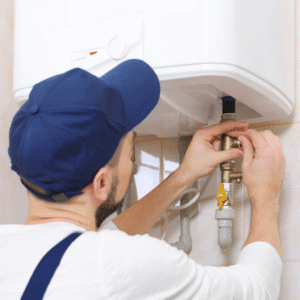
Selecting the Right Water Heater for Your Needs
Choosing the right tankless water heater starts with matching hot water capacity to the home’s peak demand.
From there, cost, available space, and energy use help narrow the options.
With these factors in mind, a homeowner can pinpoint the model that best fits their needs.
Matching Hot Water Capacity to Household Demand
Capacity is the heartbeat of a tankless water heater’s performance. To ensure reliable hot water, the unit’s flow rate must align with real usage.
Matching hot water capacity to household demand means tallying simultaneous fixtures—showers, sinks, laundry—and selecting a tankless model that keeps pace. When a lot of hot water is needed at once, choose a heater whose tankless hot water output meets peak flow.
- Count peak fixtures (e.g., two showers plus a sink)
- Add their flow rates for total gallons per minute
- Consider groundwater temperature to size accurately
- If demand is high, a tankless water heater is greater when using multiple units or cascading systems
Cost, Space, and Energy Considerations
After sizing for peak demand, the next decision balances budget, footprint, and efficiency.
Initial cost differs: tankless water often costs more to install, while a tank water heater is cheaper upfront. Over the long run, tankless models can save energy by heating only when needed. A tank water heater uses storage water, cycling heat and losing some energy.
Space matters, too: compact tankless units free floor area, helpful in tight homes. Consider fuel type, venting, and maintenance.
If a heater operates intermittently, it uses less energy; if it runs constantly, expect higher costs. Choose a water heater that fits both your available space and operating budget.
Finding the Best Water Heater for Your Needs
What matters most to the household: steady hot water for multiple fixtures, the lowest upfront cost, or long-term efficiency?
The right choice depends on how systems work and how long they last. Traditional water heaters store water, keeping water in the tank hot until you turn on your hot water. They’re simple and affordable, but cycle to heat water and lose energy.
Since a tankless water heater heats on demand, it saves space and boosts efficiency.
- Large family, simultaneous showers
- Smaller home, tight budget
- Long-term savings, limited space
- Hard water, maintenance plan
Match capacity, fuel type, and installation costs to usage patterns and local energy rates. Learn more in our detailed guide: How to Replace a Water Heater Without Any Hassle.
Conclusion
A tankless water heater offers on-demand hot water, energy savings, and a compact footprint, making it a smart upgrade for many homes. By heating water only when needed, it reduces standby losses and can last longer than traditional tanks. Still, proper sizing, installation, and maintenance are essential for performance. Homeowners should compare fuel types, flow rates, and local costs before choosing. With the right model and professional setup, a tankless system delivers reliable comfort and efficient, long-term value.



